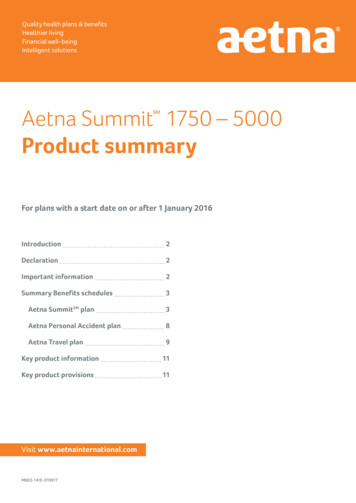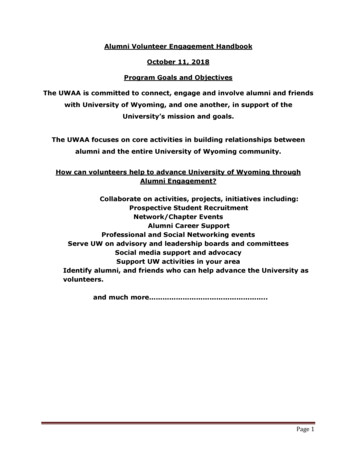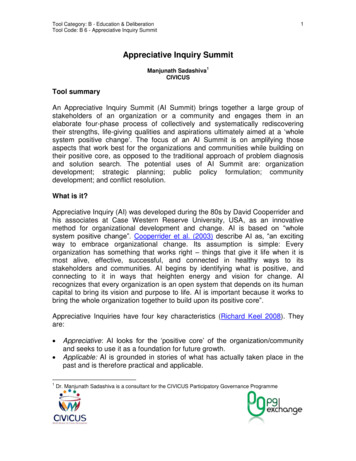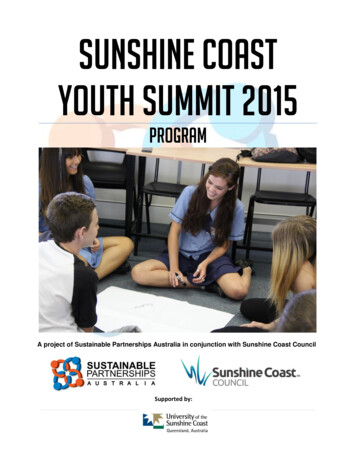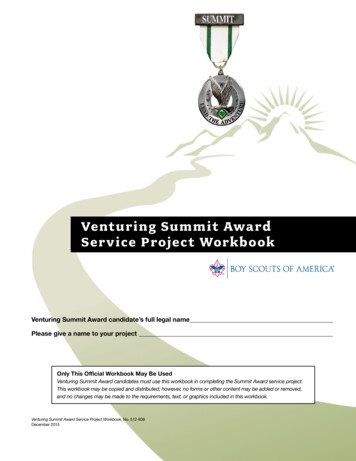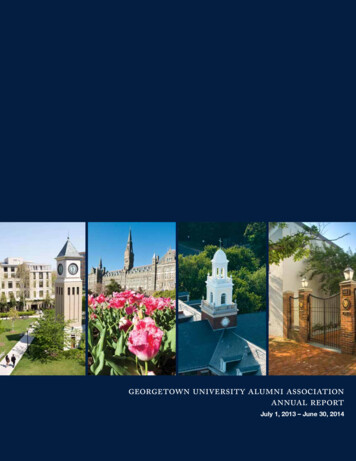
Transcription
ionFouna daN tieSt w onra Ar fote ts rgy EducatEducation Leaders InstituteAlumni Summit Report
National Endowmentfor the ArtsJoan Shigekawa,Acting ChairmanPatrice Walker Powell,Deputy Chair, Programsand PartnershipsAyanna N. Hudson,Director of ArtsEducationLaura Scanlan,Director of State andRegional PartnershipsPublished byNational Endowmentfor the Arts400 7th Street SWWashington, DC 20506arts.govArts Education April 2014Based on evaluation reportsand interviews conducted byRob Horowitz.Designed by Faust, Ltd.Cover Image: From the EducationLeaders Institute. Photo by NatiSoti, Zero One ProjectsLakita Edwards,Arts Education SpecialistFor individuals who are deaf or hearing-impaired.202-682-5496 Voice/TTYIndividuals who do not use conventional print materialsmay contact the Arts Endowment’s Accessibility Office at202-682-5532 to obtain this publication in an alternate format.This publication is available free of charge in print or PDF format atarts.gov, the website of the National Endowment for the Arts.
Welcome1Introduction3The ELI Process5Catalysts to Advance Arts Education8Next Steps for the National Endowment for the Arts 17Share Your Stories23A multifaceted problemrequires a multifaceted solution(Image was created by a visual note-taker at theEducation Leaders Institute (ELI) Alumni Summit)
ucIn atst ionSu itut Lem e A adm lu eritsRe mnpo irtEd1WelcomeOver the course of five years, from 2008 - 2012, the National Endowmentfor the Arts provided leadership and reflective space through the EducationLeaders Institute (ELI) for executive-level, cross-sector state teams toaddress the goal of ensuring access to arts education for all students.During this five-year period the NEA invested 1 million dollars and hostedteams from 29 states.Every Americanstudent should havethe opportunity toparticipate in thearts. In fact, researchsupported by theNational Endowmentfor the Arts (NEA)has shown studentswho participate inthe arts are moreengaged in life andare empowered to befulfilled, responsiblecitizens who canmake a profoundpositive impact onthis world.I am pleased to present this Education Leaders Institute Alumni SummitReport which shares the significant findings of what the NEA, its partners,and participating states learned together. Our goal is that this report willassist both national and state-level policymakers in understanding thecatalysts to advance the arts as a core element of education.The findings of this report helped to shape the priorities, leadership, andinvestments in arts education for the NEA. Incorporating what we learnedfrom the 2013 summit, the NEA developed a new arts education strategicplan that is included in this report. We believe that when implementedover time, this plan will move us towards our vision for arts education inthis country: that every student is engaged and empowered throughan excellent arts education.I would like to thank the Illinois Arts Council Agency and the IllinoisHumanities Council for their strategic partnership in the design andimplementation of ELI over the five-year period, under the steadfastleadership of Libby Chiu and Tatiana Gant. In addition, a special thankyou to participants from the cross-sector state teams, the dynamic ELIcoaches, and the provocative speakers for their willingness to stretch,grow, and learn on behalf of America’s students.I hope that this report encourages you to not only think deeply, but alsotake action.Joan ShigekawaActing Chairman,National Endowment for the Arts
2D.C.EducationLeadersInstituteELI 1 March 2008ELI 5 July 2010Alaska State Council on the ArtsArts Alliance IllinoisKentucky Department of EducationNew Hampshire State Councilon the ArtsNebraska Arts CouncilNorth Carolina Arts CouncilOhio Arts CouncilWisconsin Departmentof Public InstructionOregon Arts CommissionWashington State Arts CommissionELI 2 July 2008ELI 6 May 2011Colorado Creative IndustriesCalifornia Arts CouncilLouisiana School for Math,Science, and the ArtsIdaho Department of EducationMichigan Department of EducationMissouri Arts CouncilOklahoma StateDepartment of EducationKansas Arts CommissionSouth Dakota Arts CouncilRhode Island StateCouncil on the ArtsELI Alumni SummitDecember 2012ELI 3 March 2009Alabama State Council on the ArtsArizona Commission on the ArtsDC Arts and HumanitiesEducation CollaborativeHonolulu Theatre for Youth (Hawai’i)Appalachian Education Initiative(West Virginia)ELI 4 June 2009Alabama State Council on the ArtsIndiana Arts CommissionMaine Arts CommissionNew Mexicwo ArtsUtah Division of Arts and MuseumsCalifornia Arts CouncilLouisiana School forMath, Sciences, and the ArtsMissouri Arts CouncilNebraska Arts CouncilNorth Carolina Departmentof Public InstructionOklahoma A Schools at theUniversity of Central OklahomaWisconsin Departmentof Public Instruction
ucIn atst ionSu itut Lem e A adm lu eritsRe mnpo irtEd3IntroductionA current observation in the field of arts education is there are twooverall trends, both powerful and yet contradictory. On the one hand,arts educators are struggling to maintain their tenuous foothold in theclassroom in the wake of the movement for higher academic standardsin other subjects, testing requirements, and budget cuts. On the otherhand, there is a growing and compelling body of research illustratingthe benefits of arts education for students and schools, which is nowcentralized in the Arts Education Partnership’s online research and policydatabase, ArtsEdSearch.org. In addition, recent National Endowment forthe Arts (NEA) research1 indicates high-quality arts education is essentialfor a complete education that prepares children to fully participate, andcompete, in today’s complex, dynamic, and creative global economy. Andyet, keeping the arts as central to the curriculum is an ongoing challenge.A “wicked problem,” to be sure.“A wicked problem is a socialor cultural problem that isdifficult to solve for as manyas four reasons: incomplete orcontradictory knowledge, thenumber of people and opinionsinvolved, the large economicburden, and the interconnectednature of these problems withother problems.”Wicked Problems: Problems Worth Solvingby Austin Center for DesignIn light of this reality, the question facing the NEA in 2008 was:How can leaders develop systemic support forarts education for all students within pre-K through12th-grade education?To help answer this question, the NEA launched the EducationLeaders Institute (ELI). Bringing together executive-level,cross-sector state teams, ELI provided space to explore anddebate prominent arts education issues and key questions toadvance arts education, and to hear from provocative speakerswho challenged current assumptions about arts and education.Over a five-year period, teams from 29 states participated inELI, with eight of these teams returning to attend an ELI AlumniSummit in December 2012. The purpose of the summit wasto share progress, challenges, and lessons learned, as well asdeepen understanding of the critical elements necessary toadvance arts education.
ucIn atst ionSu itut Lem e A adm lu eritsRe mnpo irtEd4This Education Leaders Institute Alumni Summit Report is designed toillustrate the significant findings from the Arts Endowment’s investment inELI and assist both national and state-level policymakers in understandingcatalysts to advance the arts as a core element of education:1. Cross-sector collaboration of state-level policymakers;2. A laser focus on changing the systems thatserve students;3. A sustained, coordinated effort of the state-levelpartners over time; and4. Alignment of arts education with state-wide priorities.The NEA has taken to heart thewords of one ELI participant —“My hope is that we will learnfrom each other and we willwalk away with a focus.We need a vision, as a country,for how we can continue toadvance the priorities witharts education as core to everychild’s education. We have thearts as core academic subjectsunder federal legislation,but what’s happening in theschools is not equitable inour state and it’s not equitableacross the country.”The findings of this report are also shaping the priorities,leadership, and investments in arts education for the NEA.Incorporating what we learned from ELI, the NEA has developeda new arts education strategic plan that is included in thisreport. We believe that when implemented over time, this planwill strategically move the field towards the agency’s vision forarts education in this country: that every student is engaged andempowered through an excellent arts education.VSA (Very Special Arts) Texas leads students in a drum circle. Photo courtesy of VSA Texas
ucIn atst ionSu itut Lem e A adm lu eritsRe mnpo irtEd5The ELI ProcessNEA borrowed the successful structure of the NEA Mayors’ Institute on CityDesign2 to help answer the question: How can leaders develop systemicsupport for arts education for all students within pre-K through 12th-gradeeducation? Through a cooperative agreement with the Illinois Arts CouncilAgency, between 2008 and 2011, six-member, executive-level teams from29 states each convened in Chicago, Illinois, for two and a half days.The NEA Mayors’ Institute on City Design organizes sessions where a selectgroup of mayors engage leading design experts to find solutions to themost critical urban design challenges facing their cities. Like the Mayors’Institute, sessions were organized around case-study problems. Each ELIteam presented a challenge from their state and engaged the other teamsto discuss. This process used the creative approach of what has come to beknown as “design thinking.” The idea to utilize the design process as a wayto analyze and innovate has been widely embraced—from business schoolsto major consulting practices—and was the foundation of the EducationLeaders Institute.The NEA and its partners created a competitive process for stateparticipation in ELI. Applicants submitted a proposal that was reviewedby an expert panel convened by the NEA. After a thorough review anddiscussion, this panel recommended states for ELI participation to theNEA and Illinois Arts Council Agency. As a part of the proposal process,each state was required to identify executive-level team members thatwere able to commit to participate in ELI prior to, during, and after theinstitute. Leadership of these teams was usually from the state artsagencies or the state departments of education. Team members consistedof diverse stakeholder groups, including state legislators, governor’scabinet members, state school board members, superintendents, publicsafety officials, district-level school leaders, artists, arts advocates, highereducation administrators/faculty, philanthropists, and business leaders.
ucIn atst ionSu itut Lem e A adm lu eritsRe mnpo irtEd6As part of the design of the institute, each team developed a guidingquestion that would be the focus of the states’ exploration during ELI.Before arriving at the institute, each team was assigned a coach to serveas both a resource and facilitator. Coaches were matched based on theexpertise and knowledge needed to support teams in the search for theanswer to their guiding question.“The suggested readings werevery helpful. They hit it out ofthe park for us, I’ve got to say.The readings and the speakerswere really what we needed toopen our thinking, expand ourminds and look at the problemin different ways.”During ELI, state teams presented on the unique challengesfaced by their states. Provocative speakers3 and readingassignments4 challenged participants’ current thinking as theyexplored a wide range of issues, including opportunities forgalvanizing public will, the role of technology, and approachesfor developing regional support for arts education.Breakout sessions within and across state teams providedopportunities for visionary dialogue and to explore how thespeakers’ ideas and the issues raised in the reading assignmentsaddressed state needs. Artists served as visual note takerscapturing real-time epiphanies. The speakers, readings, and the new insightsserved as the foundation for each state team to affirm, revise, or completelyre-imagine their question and possible solutions. Each state team thendeveloped a roadmap for actions to take once they returned home.As the Alabama team reflected on their experience in ELI, the mostprofound impact was the provocative speakers. Seventy-five percent of thetime on the agenda was dedicated to these presenters and discussions,whereas planning took less than 25 percent. One team member wanted tospend more time planning, but realized the value of the dynamic speakersintroducing innovative ideas to the cross-sector executive-level teammembers, many with no background in arts education. And in hindsight,this team member observed that even those with deep experience in artseducation needed a bit of shaking up.
ucIn atst ionSu itut Lem e A adm lu eritsRe mnpo irtEd7ELI Alumni SummitIn response to the interest of institute participants to reconnect and gainsupport for their ongoing state-level education policy work, the NEA, withits partners the Illinois Arts Council Agency and the Illinois HumanitiesCouncil, convened an ELI Alumni Summit in December 2012. Based inChicago, the alumni summit provided an opportunity to share lessonslearned and investigate current challenges in an environment wheresuccesses and failures were of equal importance.“It really is amazing what canhappen when you bring agroup of passionate, intelligentpeople together aroundthe subject and you come upwith solutions that you nevercould have dreamed of inisolation. Getting acouple of days to wrap yourhead around these issues isreally important and all toorare, at least in the workI have to do day-to-day.”States that previously participated in ELI were invited to submita proposal to attend the alumni summit. This time states werelimited to only two members, one of which was required tobe from the original ELI team. Eight teams were ultimatelyselected. These teams showed a strong connection to thequestion investigated by their original ELI team, articulated theimpact of ELI on their thinking and practice, and demonstratedsustained progress after their ELI participation.Participation in the alumni summit required full immersion—twoand a half days, from early morning to late night. Through fourforward-thinking reading assignments5 on collective impact,the role of leadership in creating a climate for change,disseminating innovations, and wicked problems, the summitprovided a reform-based theoretical framework to supportreflection and planning.Unlike the original ELI experience, the summit eliminated the presentersthat had been provided during ELI to stimulate team thinking. Instead,the summit focused on the participants themselves. Through teampresentations and intensive dialogue facilitated by previous ELI coachesand speakers, participants reviewed the impact of their ELI experienceand the subsequent successes and challenges in their respective states.The summit created a space for participants to react to the provocativeliterature and explore with each other both current best practices gainedfrom the previous ELI and the challenges they currently face. Discussionswere in-depth and profound.
ucIn atst ionSu itut Lem e A adm lu eritsRe mnpo irtEd8Catalysts to AdvanceArts EducationDrawing from knowledge gained by participants in the ELI Alumni Summit,this report presents four key catalysts to advance the arts as a coreelement of education. Through an analysis of the overall design of ELI,proposals submitted to the NEA for participation in the alumni summit,interviews with the participants during the alumni summit, and evaluationforms completed by participants after the summit, four major findingsemerged for advancing arts education:Cross-Sector CollaborationSystemic ChangeBuilding Consensus forSustained CommitmentAligning PrioritiesChicago public school students participate in Hubbard Street Dance Chicago’s education residency. Photo by Todd Rosenberg
ucIn atst ionSu itut Lem e A adm lu eritsRe mnpo irtEd9Cross-Sector CollaborationELI required state participants to submit a team of “unusual suspects”representing each state’s varied constituencies. Critical to the successof ELI state teams was that the team members came from differentbackgrounds, with different work roles and responsibilities. In fact, theLouisiana team shared their state’s use of “power mapping” to identifythe key decision-makers from across the state. While power brokerslook different in each state, in general the most successful ELI stateteams consisted of some combination of representation from statelegislators, governor’s cabinet members, state school board members,superintendents, public safety officials, district-level school leaders, artists,arts advocates, higher education administrators/faculty, philanthropists,business leaders, and others.While some state team members had worked together beforeELI, often the state team had minimal prior collaborative“There’s been this wholeexperience. ELI provided the critical venue for working acrosscatalyst-like energy that cameartificial boundaries, defeating the inertia and silos within statesout of ELI. People were workingthat can impede innovation. The mingling of work roles led toin silos and there wasn’t thisunexpected, out-of-the-box conversations. Varied backgroundsstate-wide effort until ELI.”provide the opportunity for looking at issues from multipleperspectives. A police chief, for instance, was as likely toprovide insight into arts learning as a state education official. State teammembers often said how much they relished the unique opportunity forin-depth reflection, conversation, and planning with people from differentbackgrounds who could rally other constituencies.T.S. Cooper Elementary in Gates County, North Carolina, participates in the A Schools Program to integrate the arts into core curriculum.Photo by Michelle Mazan Burrows
From the Education Leaders Institute. Photo by Nati Soti, Zero One Projects“It was a challenge to assemble that team, but very strategic.One of the resonating ideas was: ‘Who is not at the table?’I think we often find ourselves surrounded by likeminded people,and we’re just preaching to the choir.”The diverse representation was essential to state teams’ successbecause it ensured that any post-ELI plans could include each state’squilt of diverse constituencies. For instance, an ELI representativeon the Nebraska team realized that their conversations on artseducation did not include the broader creative community, includingindustries that had a stake in assuring that the arts are included inK through 12th-grade education. Once the Nebraska team returnedhome, they formed a Creative Industries partnership with theirstatewide advocacy organization, Nebraskans for the Arts, whichmerged with the Nebraska Alliance for Arts Education. Through theinclusion of the creative business sector, the Nebraska team expectsto make educational connections to arts-related industries, such asadvertising, independent music, publishing, and design. This shouldprovide new opportunities for instruction tied to school-to-workinitiatives in the creative industries.
ucIn atst ionSu itut Lem e A adm lu eritsRe mnpo irtEd11Systemic ChangeState team members said that providing equitable access to high-qualityarts education to all students—versus pockets of excellence for some—was their highest priority. Indeed, it was a moral imperative. Through theirparticipation in ELI, they came to understand that piecemeal approachesdedicated to a specific need might have an isolated impact, valuable tosome, certainly. However, ensuring arts education for all students is a“wicked” problem—a problem that is not easily solved because of unclearsolutions and a complex web of impediments, some known andsome seemingly unknowable—and demands a different way“It took us four years to getof thinking. While challenging, the ELI state teams came tocertified teachers in theunderstand systemic change, defined as “change that permeatesclassroom. It took us threeall parts of a system,”6 at a local, state, and national level wasessential to building and sustaining support for arts education.years to get the School for theArts. It’s a lifetime of work.It’s not something that you doimmediately and you’re done.People have to realize we’re init for the long haul. It took along time for the schools to getin the condition they’re in nowand it’s going to take a while toget them back on track.”Even if these problems can’t be immediately “solved” theycan be addressed by individuals and institutions willing to lookbeyond the silos and find common ground with others whoshare similar goals, albeit with different experiences and workroles. As diverse groups truly work together for a combinedeffect, the overall interlocking system of policy leadership,business interests, philanthropies, and educators can start tochange and move together. The ground can shift, and systemicchange can begin to happen. The need to provide equitableaccess to high-quality arts education for all students motivatedteam members to continue the work they crafted at ELI, andmove towards changing the fundamental dynamics that impeded changein their states. ELI teams took a systemic approach to strengtheningarts education through policy changes, legislation, state-wide coalitions,regional arts networks, school-based educational programs, andgrassroots engagement.
ucIn atst ionSu itut Lem e A adm lu eritsRe mnpo irtEd12For example, the Missouri ELI team’s goal was high quality arts instructionfor all students across the state. With a strategy to focus on policy makers,the team set about trying to make sweeping, bold policy changes that wouldbenefit all schools at once. A Missouri ELI team member, who was vicepresident of the State Board of Education, asked the state’s department ofeducation to require all school districts across the state to demonstrateadequate instruction in the arts as part of the school accreditation system.While the state’s department of education ultimately did not includethe requirement as recommended, a state-wide advocacy coalition wasput in place to ensure its ultimate inclusion in the accreditation system.Furthermore, state legislators and members of the state board of educationserve in an advisory capacity to aid these efforts.“There’s a huge variance ofaccess and equity across thestate. I’d say that’s the primaryissue we focused on thatcontinues to drive our work.Yes, equitable access to artseducation. I also see that asa national focus and I thinkthat’s the continual thread thatruns through all of this: howdo we open doors so that allstudents receive the benefitsof the arts and what does thatlook like?”The Missouri team was successful in developing a technologicallyadvanced student-level arts assessment in dance, music, theater,and the visual arts. Piloted statewide, this assessment willultimately benefit all schools, teachers, and students across thestate. The Missouri team is in the process of developing additionalarts assessments that can be used by school districts as anindicator of adequate arts instruction.A student at work on a “Mighty Tieton” mosaic, part of the Tieton Mosaic Projectby Tieton Arts & Humanities in Washington State. Photo by Ed Marquand
ucIn atst ionSu itut Lem e A adm lu eritsRe mnpo irtEd13Building Consensus forSustained CommitmentState team members represented different constituencies, had differentwork roles in their home state, and often came to ELI with differentagendas for supporting arts education. Teams worked through innovativeoptions for addressing their wicked problems at ELI by developing acommon set of objectives. When various stakeholders within the states’political, cultural, educational, and business systems agreed on commongoals for arts education and acted in concert, they had a much greaterlikelihood of success in implementing their post-ELI plans and achievingtheir goals for systemic change.In fact, after participating in ELI, the most successful state teams madesustained efforts to collect data, plan, and engage other state leaders andconstituencies. The efforts in North Carolina were propelled forward bythe appointment of a Joint Select Committee on Arts Education to studythe current status of arts education in the state. A subsequent legislatedArts Education Task Force, appointed by the North Carolina State Boardof Education and co-chaired by the Department of Public Instruction andDepartment of Cultural Resources, met for six months.“I think ELI brought those keyplayers together to have aconversation that would nothave taken place otherwise.It definitely would not havebeen as strategic. ELI directlyimpacted the state leadershipconversation that has helpedus to have a common visionof comprehensive artseducation and where we’reheaded in our state.”The coordinated efforts of the state Department of Educationand the Department of Cultural Resources, along with task forcemembers representing legislators, principals, superintendents,professional associations, parents, arts organizations, artseducators, general education classroom teachers, teachingartists, business, and institutions of higher education, wasessential towards developing a common vision; a shareddefinition of comprehensive arts education that includes artslearning, arts integration, and arts exposure; and a detailed actionplan for implementing a comprehensive arts education in NorthCarolina’s public schools. Submitted to the state legislature,the comprehensive arts education plan is being implementedby the two state agencies and others, representing all facets ofthe task force. According to the ELI team, “Taking ownership ofcomponents of the plan by the appropriate parties has increasedour state’s capacity to work toward common goals.”
ucIn atst ionSu itut Lem e A adm lu eritsRe mnpo irtEd14Maintaining the sustained attention of state team members could bea challenge, particularly when they came from different organizationsand had different work roles. The most successful state teams hadcommitted members who continued to work together effectively aftertheir ELI experience, with a partner coordinating their efforts. Regularlyscheduled meetings and focused objectives helped the teams sustain theircommitment and reach their goals. The teams continued to engage otherstakeholders within their states to leverage additional support. State teamsconsidered how to manage their arts education initiatives and ensure thatdifferent constituencies were included in the decision-making process.Progress was sometimes slow but the groups that persevered and adaptedto new and changing circumstances made the most progress.“ELI created a space for disparate organizations that hadbeen doing some work together to form a partnership anda commitment to continuing the work. We came up withspecific goals that we wanted to accomplish within a year,a blueprint for arts education.”Creative Action works with Austin students. Photo courtesy of Creative Action
ucIn atst ionSu itut Lem e A adm lu eritsRe mnpo irtEd15Inspired by their participation in ELI, the California team began a seriesof forums and state conversations to build support for arts education.Through sustained collective effort, an umbrella movement, CREATECA, was developed to advance an arts and creative education agenda.More than 600 invested participants included senior leadership from theCalifornia Department of Education, the California Arts Council, as wellas the California Alliance for Arts Education and the California CountySuperintendents Educational Services Association. The team soughtto ensure that all constituencies were included, with an ethnically andgeographically diverse base of support. Through sustainedefforts, a “culture of trust and cooperation” was developed“I think the hardest part wasamong participant organizations.that some passionate leaderswere in place during ELI and they left office at that particulartime. Other people who are partof the team are still relativelyclose to the arts, but they haveretired or taken on differentpositions. It’s been a challengeto find people to keep the workmoving forward I’ve felt verycomfortable in contacting [otherleaders in my state] and findingout what their ideas wereand what they saw wouldbe good for the entire state.”The CREATE CA movement has developed a blueprint forcreative schools, along with an action plan to implementits recommendations. The state ELI team is confidentthat CREATE CA “can lead California to an integrated,student-centered educational structure that will build onCalifornia’s diversity to strengthen student achievement andsupport California’s creative economy.” Recommendationsinclude expanding arts instruction and integration in lowperforming schools, including arts and creative educationin state assessments, and strengthening the collaborativerelationship between credentialed arts specialists and teachingartists. Most important will be the continued, sustainedengagement and commitment from all constituencies thathas proven so successful in building collective impact insupport of arts education.From the Education Leaders Institute. Photo by Nati Soti, Zero One Projects
ucIn atst ionSu itut Lem e A adm lu eritsRe mnpo irtEd16Aligning PrioritiesELI state teams struggled with balancing the need for expanding accessto arts education with competing state priorities. ELI helped each state toposition their arts initiatives within the broader movements of educationalreform, economic growth, and innovation. Involvement with ELI providedcachet, legitimacy, and recognition, and helped propel the efforts of thosestruggling to coordinate state resources in the service of arts education.The message to the home states was that this was important. Teammembers were part of a national, multi-
4. Alignment of arts education with state-wide priorities. The findings of this report are also shaping the priorities, leadership, and investments in arts education for the NEA. Incorporating what we learned from ELI, the NEA has developed a new arts education strategic plan that is included in this report.

